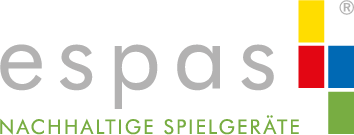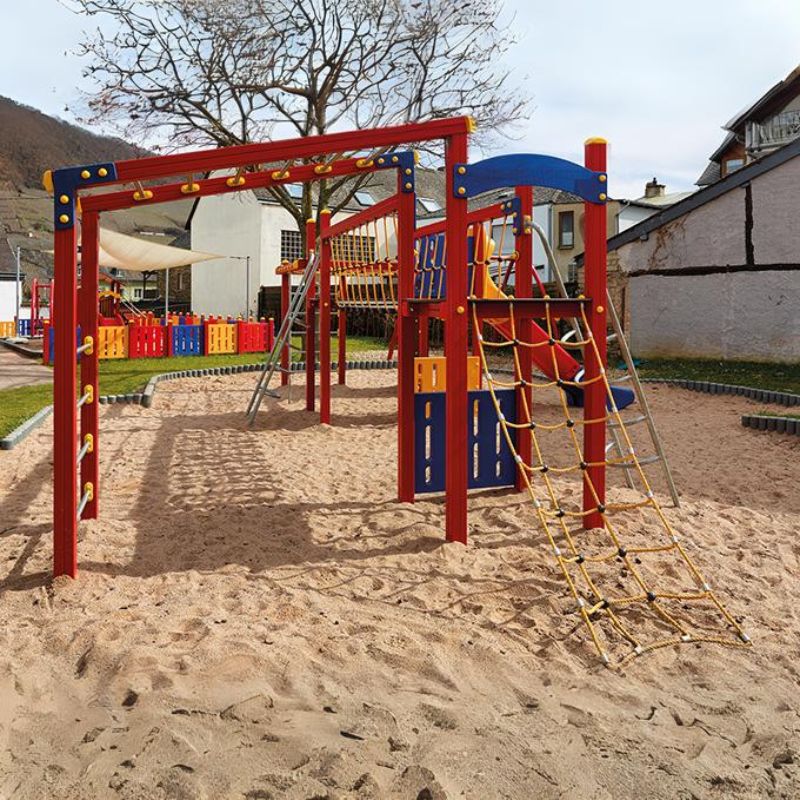
Top security level
The playground standards EN 1176 and 1177
EN 1176 and EN 1177 came into force as playground standards in 1998 and are regularly updated. Their purpose is to ensure an appropriate level of safety when playing in, on, and around playground equipment. Playing with playground equipment benefits children. It provides them with valuable experiences that enable them to cope with situations outside of playgrounds.
To protect children from hazards so they can play and experience adventures without worry, EN 1176 precisely defines the safety requirements for play equipment, its testing, inspection, and maintenance. The EN 1177 standard specifies values for the shock-absorbing properties of the flooring beneath play equipment and describes the associated testing procedure.
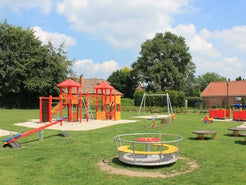
Scope
The playground standards apply exclusively to site-specific playground equipment
- on public playgrounds
- in kindergartens
- in schools and similar institutions
- in the private sector only in certain facilities such as beer gardens, residential complexes or play areas in department stores.
These standards do not apply to private playground equipment in one's own garden, even if it is made of metal. These devices are classified as "toys" and are not subject to playground equipment standards.
EN 1176 specifies requirements for play equipment to protect children from hazards when used properly. However, this does not relieve supervisors of their duty of supervision when children play on this equipment.

Structure of playground standards
The playground standards are primarily aimed at equipment manufacturers and playground operators. EN 1176 is divided into seven areas:
- Part 1: General safety requirements and test methods
- Part 2: Additional specific requirements and test methods for swings
- Part 3: Additional specific requirements and test methods for slides
- Part 4: Additional specific requirements and test methods for cableway installations
- Part 5: Additional specific requirements and test methods for carousels
- Part 6: Additional specific requirements and test methods for rocker devices
- Part 7: Instructions for installation, inspection, maintenance and operation
EN 1177 has only one section that regulates shock-absorbing playground surfaces, safety requirements and test methods.
Below you will find an excerpt of how detailed the requirements of EN 1176 and EN 1177 are to protect children from dangers.

Ban on poisonous plants
According to the playground standard EN 1176, the following plants are not allowed to grow on playgrounds to prevent children from being exposed to the risk of poisoning: spindle tree, daphne, holly and laburnum.
You can find more information about plants for the playground here.
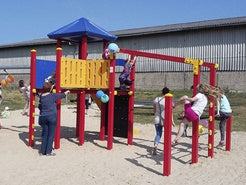
Design and execution
The structural strength of the equipment must be verified mathematically or through a load test according to DIN EN 1176. The load-bearing components must be extremely resilient. If the stability of a piece of equipment depends on a post, it must be possible to monitor for weakening and dismantle it if necessary. If the play equipment is made of wood, it must not have a rough surface and only a low tendency to splinter.
As a playground equipment manufacturer, we pay close attention to the specifications.
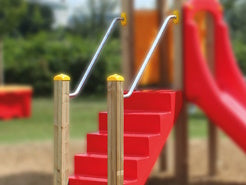
Hedging
The handrail is a safety feature designed to help the user maintain balance. Its installation height is 600 to 850 mm.
The purpose of the railing is to prevent users from falling. It is also installed at a height of 600 to 850 mm. It must extend completely around the play equipment, except for the entry and exit areas. For bridges, slides, and similar attachments, the railing opening must be as wide as the attached play element.
The parapet is a safety feature designed to prevent falls and, in addition, prevent the user from sliding underneath. It is installed at a height of at least 700 mm. It is required for playground equipment with a fall height of two to three meters. If the fall height is greater than three meters, the parapet must be designed to prevent children from climbing over it.
All of our play equipment is constructed according to these specifications.
Test specimens for checking conformity to standards
Entanglements occur when the head, neck, hair, body, body parts or clothing can get caught in a part of a play equipment and the child cannot free themselves.
Special commercially available test specimens can be used to test for potential trapping points. This allows, for example, to check whether the opening and gap dimensions specified by EN 1176 are being met. Tests are necessary.
- when building a new playground equipment,
- when a new piece of playground equipment is installed,
- during the annual safety inspection of a piece of playground equipment,
- if there are changes in the design of the playground equipment.

Detailed specifications for individual play equipment
EN 1176 explicitly regulates the requirements and testing procedures for swings, slides, cable cars, carousels, and seesaws. Our play equipment is designed, built, and tested according to these regulations. You can therefore rest assured that all play equipment you purchase from espas complies with this standard.
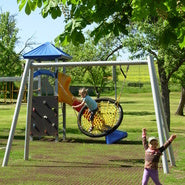
Regular maintenance of the playground
According to the playground standard EN 1176, inspection and maintenance are divided into three parts: the visual route inspection, the operational inspection, and the annual main inspection. Read more about these inspections in our article: Playground Inspection and Maintenance.
